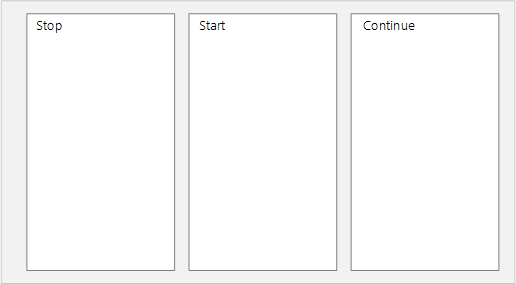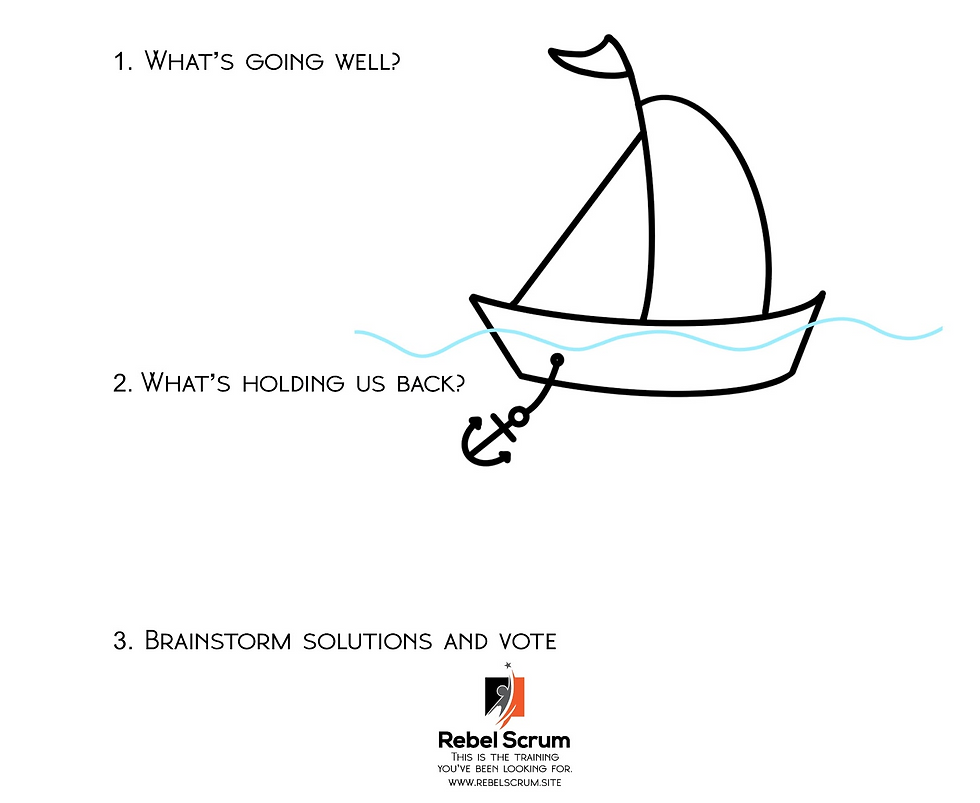Ideas for Scrum’s Sprint Retrospective Event
- Mary Iqbal

- Sep 26, 2021
- 5 min read
Updated: Oct 31, 2022
When using the Scrum framework, the Retrospective is the final event in a Sprint. The Retrospective allows the team to identify how to work together better and improve the quality of the product. Whereas the Sprint Review is an opportunity to inspect the increment, the Sprint Retrospective is an opportunity for the team to inspect themselves. During this event, the team discusses how the Sprint went regarding individuals, interactions, processes, tools, and their Definition of Done.
As an outcome from the Retrospective, the team identifies ideas for improvement and implements them as soon as possible. Many teams decide to place improvement ideas into the next Sprint Backlog to make their completion more likely and add transparency.
Like all other events in the Scrum framework, the Sprint Retrospective is timeboxed. It runs to a maximum of three hours for a one-month Sprint; the event is usually shorter for shorter Sprints.

Who facilitates the Sprint Retrospective event?
The Scrum Guide leaves this point open, but it’s usually the Scrum Master who facilitates the event in practice. I would recommend that the Scrum Master encourage others to facilitate the event, too, because this tends to bring out different perspectives and a different focus, which can benefit the team. Have the Product Owner facilitate some events or ask the Developers to take turns. Teams might also consider having guests - such as IT resource managers or security SMEs - attend or even facilitate the event, especially if there are organizational or technical issues impacting the team that the resource manager might help resolve.
Retrospective ideas
Each team can decide how to run their Sprint Retrospective, and changing approaches from time to time can help keep things fresh. Below are a few agenda ideas: try them out and leave a comment to tell me how it went or to share other ideas you have.
What went well; what didn’t go well; ideas for improvement

I am a straightforward person, and my favorite retrospective is the simplest one. Reproduce the columns below on a shared physical or electronic whiteboard (see remote facilitation section below for tools). Ask team members to place sticky notes under each column to share their ideas. Then, select one to three items from the ideas for improvement section for the team to focus on during the next Sprint. Remember, you often can’t do everything, so only select a few of the best ideas for improvement and leave the rest.
Stop-start-continue

This is another simple Retrospective idea, which I sometimes use for the sake of variety. As with the above example, ask team members to share their thoughts using sticky notes under each column. Select one to three ideas from the start column for the team to focus on during the next Sprint.
Drop-add-continue-keep

Similar to the previous two ideas, this facilitation technique is a way for Scrum team members to think about what they should stop (or drop) doing, what they should start (or add) to their processes, what they should continue doing, and what they should keep. Continue often refers to processes, and keep frequently refers to tools. Remember to ask team members to consider individuals, interactions, processes, tools, and their Definition of Done when participating in the Retrospective. If your team uses the complementary practice of team agreements, you should also occasionally inspect those at the Sprint Retrospective. Remember, Rome wasn’t built in a day, and even small incremental improvements to a team’s processes can make a startling difference over time.
1, 2, 4-All

This exercise is based on the 1, 2, 4, All technique from LiberatingStructures.com, which you can modify based on group size. To start, ask each individual to brainstorm ideas for improvement. Then, ask individuals to pair up to share their ideas and choose the best one. Next, ask each pair to form a group of four with another team and have them compare ideas to select the best one. Finally, all groups come together, and each foursome shares their ideas. To complete the exercise, the group as a whole decides the best improvement idea to focus on in the upcoming Sprint.
I encourage you to visit www.LiberatingStructures.com for more ideas; you could use almost any of the techniques on the website to create a productive Retrospective.
Focus

I like this one because it incorporates the concept of visioning. Using this technique, you ask team members where they would like to go? Decide what the team should look like in six months, and then ask what is holding them back from that and how they can resolve the impediment. If you are focusing on specific improvements, you can use this technique for one or two Retrospectives in a row so that the team can see progress over time.
Sailboat analogy

This is another one of my favorite Retrospective ideas because it’s simple. It’s also entertaining to see the Scrum Master attempt to draw the visual involved. Fortunately, Mural has a nice template that uses a variation of the sailboat analogy. Simply draw a sailboat and ask what’s going well or what’s propelling the team forward. Second, ask what’s holding you back or what’s not going well. Finally, ask the group to brainstorm ideas for improvement and vote on the best one to carry forward into the next Sprint.
5 whys

If a team is confronting a problem and is unsure of the exact root cause, the 5 whys exercise taken from the business analysis sector can help get to the bottom of it. For example, if a team cannot get to Done each Sprint, that would go at the top of the whiteboard. The team then asks why that problem exists, writing that answer in the box below. Next, the team asks why again, but this time in response to the “why” they just identified. Continue this process until the team identifies an actual root cause, which usually becomes apparent within five steps.
Brainstorm improvement ideas and vote

If the team is very vocal, the Scrum Master can facilitate brainstorming improvement ideas. This exercise is not something that the Scrum Master should rely upon for every Retrospective because it can become boring after a while. However, when used sparingly, this simple facilitation technique can be effective.
Brainstorm improvement ideas, plot feasibility vs. importance

To take the brainstorming idea a bit further, first, ask team members to brainstorm improvement ideas. Tell them the sky's the limit and come up with anything that they think would be helpful. As a group, plot each idea on a graph with importance on the Y-axis and feasibility on the X-axis. Identifying the most feasible and most important ideas can help the team select the ones to carry forward into the next Sprint.
Processes, tools, individuals, interactions and the Definition of Done

This approach encourages team members to think more broadly. Ask team members to identify what is going well and ideas for improvement within the categories of processes, tools, individuals/interactions, and the Definition of Done. Then, ask team members to vote on which improvement ideas to focus on during the upcoming Sprint.
Do you have other Retrospective ideas? Please share them in the comments.
Remote facilitation of Sprint Retrospectives
Most teams have sorted out how to facilitate events remotely as a result of the pandemic. Conference platforms (such as Microsoft Teams, WebEx and Zoom) have shared whiteboard functionality that allows teams to have audio discussions supported by a shared whiteboard. Tools such as TFS and Jira even have specific Retrospective tools embedded. I also recommend Mural, which offers an easy-to-use shared whiteboard combined with many useful templates for retrospective meetings, a kanban board, and more. Reetrio.io is another helpful tool for online retrospectives.
Conclusion
The Sprint Retrospective is extremely useful when used correctly. After every Sprint, the team identifies at least one improvement idea to focus on during the next Sprint. Remember, even minor improvements can result in an astonishing amount of change over time - so don’t neglect this valuable process!
I’d love to know what you think. Please add your thoughts to the comments section or contact Rebel Scrum LLC at mary@rebelscrum.site.



